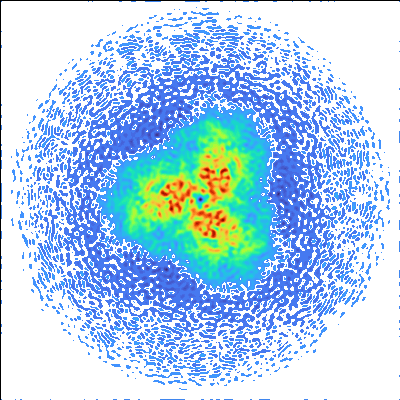EMD-28910
Glycan-Base ConC Env Trimer
EMD-28910
Single-particle4.1 Å
 Deposition: 20/11/2022
Deposition: 20/11/2022Map released: 27/09/2023
Last modified: 20/11/2024
Sample Organism:
Human immunodeficiency virus 1
Sample: HIV-1 Consensus C Env trimer with glycan covered base
Fitted models: 8f7t (Avg. Q-score: 0.351)
Deposition Authors: Olia AS, Kwong PD
Sample: HIV-1 Consensus C Env trimer with glycan covered base
Fitted models: 8f7t (Avg. Q-score: 0.351)
Deposition Authors: Olia AS, Kwong PD
Soluble prefusion-closed HIV-envelope trimers with glycan-covered bases.
Olia AS,
Cheng C,
Zhou T,
Biju A,
Harris DR  ,
Changela A,
Duan H,
Ivleva VB,
Kong WP,
Ou L,
Rawi R,
Tsybovsky Y,
Van Wazer DJ
,
Changela A,
Duan H,
Ivleva VB,
Kong WP,
Ou L,
Rawi R,
Tsybovsky Y,
Van Wazer DJ  ,
Corrigan AR,
Gonelli CA
,
Corrigan AR,
Gonelli CA  ,
Lee M,
McKee K,
Narpala S,
O'Dell S,
Parchment DK,
Stancofski ED,
Stephens T,
Tan I,
Teng IT,
Wang S
,
Lee M,
McKee K,
Narpala S,
O'Dell S,
Parchment DK,
Stancofski ED,
Stephens T,
Tan I,
Teng IT,
Wang S  ,
Wei Q,
Yang Y,
Yang Z,
Zhang B,
Novak J,
Renfrow MB,
Doria-Rose NA,
Koup RA,
McDermott AB,
Gall JG,
Lei QP,
Mascola JR,
Kwong PD
,
Wei Q,
Yang Y,
Yang Z,
Zhang B,
Novak J,
Renfrow MB,
Doria-Rose NA,
Koup RA,
McDermott AB,
Gall JG,
Lei QP,
Mascola JR,
Kwong PD
(2023) iScience , 26 , 107403 - 107403
 ,
Changela A,
Duan H,
Ivleva VB,
Kong WP,
Ou L,
Rawi R,
Tsybovsky Y,
Van Wazer DJ
,
Changela A,
Duan H,
Ivleva VB,
Kong WP,
Ou L,
Rawi R,
Tsybovsky Y,
Van Wazer DJ  ,
Corrigan AR,
Gonelli CA
,
Corrigan AR,
Gonelli CA  ,
Lee M,
McKee K,
Narpala S,
O'Dell S,
Parchment DK,
Stancofski ED,
Stephens T,
Tan I,
Teng IT,
Wang S
,
Lee M,
McKee K,
Narpala S,
O'Dell S,
Parchment DK,
Stancofski ED,
Stephens T,
Tan I,
Teng IT,
Wang S  ,
Wei Q,
Yang Y,
Yang Z,
Zhang B,
Novak J,
Renfrow MB,
Doria-Rose NA,
Koup RA,
McDermott AB,
Gall JG,
Lei QP,
Mascola JR,
Kwong PD
,
Wei Q,
Yang Y,
Yang Z,
Zhang B,
Novak J,
Renfrow MB,
Doria-Rose NA,
Koup RA,
McDermott AB,
Gall JG,
Lei QP,
Mascola JR,
Kwong PD
(2023) iScience , 26 , 107403 - 107403
Abstract:
Soluble HIV-1-envelope (Env) trimers elicit immune responses that target their solvent-exposed protein bases, the result of removing these trimers from their native membrane-bound context. To assess whether glycosylation could limit these base responses, we introduced sequons encoding potential N-linked glycosylation sites (PNGSs) into base-proximal regions. Expression and antigenic analyses indicated trimers bearing six-introduced PNGSs to have reduced base recognition. Cryo-EM analysis revealed trimers with introduced PNGSs to be prone to disassembly and introduced PNGS to be disordered. Protein-base and glycan-base trimers induced reciprocally symmetric ELISA responses, in which only a small fraction of the antibody response to glycan-base trimers recognized protein-base trimers and vice versa. EM polyclonal epitope mapping revealed glycan-base trimers -even those that were stable biochemically- to elicit antibodies that recognized disassembled trimers. Introduced glycans can thus mask the protein base but their introduction may yield neo-epitopes that dominate the immune response.
Soluble HIV-1-envelope (Env) trimers elicit immune responses that target their solvent-exposed protein bases, the result of removing these trimers from their native membrane-bound context. To assess whether glycosylation could limit these base responses, we introduced sequons encoding potential N-linked glycosylation sites (PNGSs) into base-proximal regions. Expression and antigenic analyses indicated trimers bearing six-introduced PNGSs to have reduced base recognition. Cryo-EM analysis revealed trimers with introduced PNGSs to be prone to disassembly and introduced PNGS to be disordered. Protein-base and glycan-base trimers induced reciprocally symmetric ELISA responses, in which only a small fraction of the antibody response to glycan-base trimers recognized protein-base trimers and vice versa. EM polyclonal epitope mapping revealed glycan-base trimers -even those that were stable biochemically- to elicit antibodies that recognized disassembled trimers. Introduced glycans can thus mask the protein base but their introduction may yield neo-epitopes that dominate the immune response.
